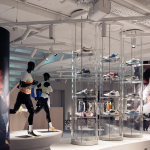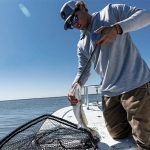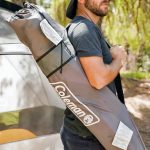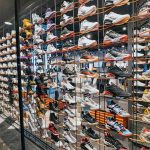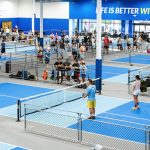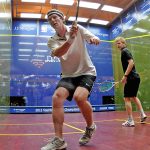At its annual franchise conference held in St. Louis in mid-June, Fleet Feet, Inc. introduced Experience 2.0, a comprehensive initiative designed to address both the technological advances that are waylaying the retail marketplace as well as the significant investments in run that are quickly transforming the run specialty channel.
The theme of the event was “Tomorrow Now,” which Jeff Phillips, President and CEO, said in an interview was “our way of communicating that the future is now to evolve our model and move the brand forward.” Fleet Feet Sports’ 15-member franchise advisory council, formed about 18 months ago, worked with Fleet Feet, Inc. leadership to develop the theme after deducing that the franchisees needed to particularly address two major trends in the market, according to Phillips.
First, there has been a significant investment flowing into the running business. From the vendor side, this includes a number of start-ups and non-traditional running footwear manufacturers targeting the running category. In addition we have seen a “proliferation of distribution” on the retail side with technical products flowing into the sporting goods chains, athletic specialty, online and many other stores all targeting the running category.
“We look at proliferation of distribution through the lens of premium technical product that as recently as five years ago was primarily sold in running specialty,” said Phillips. “That’s just not the case anymore. You can find the majority of our top 10 selling footwear styles in a lot of places.”
The other major trend is being driven by technology and the changing behavior of the “digitally empowered consumer” that has emerged over the past several years. Added Phillips, “Everyone now has an iPhone and a tablet with access to an amazing amount of information and product selection.”
That led to Experience 2.0, which “goes beyond a fit process or any singular element of our current service model and considers all of the existing and new touch points in which a customer may encounter our brand.” The strategy includes a plan to launch e-commerce by the end of 2014 as part of an overall goal of delivering a “seamless omni-channel experience.” Fleet Feet is hiring a Director of Marketing to support more consistent messaging and better leverage the Fleet Feet name across the franchise system. Experience 2.0 also involves raising its game at the store level, including everything from store layout and merchandising to interactions with customers.
“The goal of Experience 2.0 is to drive the evolution of the Fleet Feet Sports experience, and in some cases, reinvent or create entirely new ways of interacting with our customers,” said Phillips “Experience 2.0 is all about customer connectivity.”
OMNICHANNEL PUSH
Perhaps the boldest part of the plan is the omni-channel push, including the push into e-commerce.
Fleet Feet decided it didn’t want “a bunch of one offs,” or each store having its own e-commerce site, partly because it would be “really expensive and impractical on a store by store basis” for each franchise to build and manage. But Fleet Feet particularly wanted a consistent online interface and message with customers across the brand that will allow all of its franchise partners to participate and benefit.
While the franchisor has worked hard at creating a consistently high-level of in-store customer service across franchises, it would be extremely challenging to achieve a high level of brand consistency across individual franchise online sites.
“As a brand you don’t want a customer to have a radically different experience from one store to another or one online site to another, because at that point your brand starts to fracture in that customer’s mind,” said Phillips.
Moreover, Phillips said “overlaying an e-commerce solution across a retail franchise system is a complex proposition,” and Fleet Feet wanted to make sure e-commerce worked “in a seamless way with the experience we create in the store.”
Fleet Feet’s planned e-commerce platform includes a revenue-sharing program, whereby local franchises are compensated for online sales delivered into their designated marketing area. Said Phillips, “Our model is based on locally owned and operated stores and deep connections with communities and we want our e-commerce interface to reflect this as well.”
Omni-channel will provide greater visibility into inventory including being able to ship from store and pick up from store. We will be able to better leverage customer data to connect with, and reconnect with, or customers.
Ultimately, Phillips said Fleet Feet doesn’t want to “walk any customers,” or have a customer shop online or visit a competitor in an out-of-stock situation. Currently, stores can place a special order with a vendor in such situations but the process has numerous communication points along the way where it can break down and result in an unhappy customer. With an integrated online solution, “If a customer walks in and we don’t have a style, size or color, we should be able to have it on their doorstep the next day.”
Phillips said such an integrated omni-channel solution is “virtually nonexistent” in running specialty. This is still the Wild West for the channel. Phillips admitted, “We are definitely trailblazing with what we’re doing, but we feel good about the direction we’re heading.”
IN-STORE EXPERIENCE
At the store level, Fleet Feet is reexamining its interaction with customers including its popular Footwear Fit Process. Said Phillips, “We need to evolve the interaction with our customers and that includes determining what elements of the process we need to keep? What do we need to tweak, What do we need to change? What do we need to get rid of?”
Delivering a brand update to vendors, Luke Rowe, SVP, Business Development, said the Footwear Fit Process program came about because Fleet Feet found that stores weren’t “always consistent” in how they approached fitting customers. In many cases, a customer being diagnosed as an overpronator in one visit might come back to the same store next time and be identified as a neutral runner.
On the positive side, the Fit Process has been significant in bolstering Fleet Feet’s reputation across markets. When asking shoppers if they’re likely to refer Fleet Feet Sports to a friend or family member, Fleet Feet earns a mark of 92 out of 100. But Rowe notes that consumers “want more than that now.” He further pointed out that while customers are often initially surprised at the high level of service at run specialty stores, “when they get the same exceptional experience again and again, it’s no longer exceptional. That’s a challenge for us.”
At the store level, Rowe sees Experience 2.0 as less about rethinking fit and more about “a culture and idea we’re embracing that we need to continue to get better.”
Phillips said Fleet Feet will be “doubling down” on its in-store experience. This includes training associates to think beyond their role as fit experts to explore the many other needs of runners, including introducing them to other categories and solutions.” Said Phillips, “It’s about the interaction, how we introduce those products, how we communicate with our customers and ultimately how we create a better experience.”
The staff training will be complemented by improvements in store layout and merchandising. Phillips said Fleet Feet doesn’t want to only be known as “the place you go to get fit for shoes, inserts and socks.”
Rowe said Fleet Feet remains committed to apparel because “it gives us the opportunity to change the experience every time our customer walks into our door,” particularly during seasonal changes. He adds, “You can’t do that with the shoe wall.”
Beyond apparel, the goal is to be great in areas outside footwear such as nutrition and other accessories and “the retail environment and merchandising is all a part of that,” according to Rowe. As an example, he points to a second flagship Fleet Feet that recently opened in Durham, NC where the shoes were taken off the back wall and suspended. An extra focus on apparel is supported by large dressing rooms with a three-way mirror similar to those found professional apparel retailers. The store is thriving so far despite competitors such as Lululemon, New Balance, Athleta, Finish Line and a Target all within a half mile of the store.
“It’s a very sophisticated shopping experience,” said Phillips. “The whole idea is we have to evolve. We all know that the old school running specialty store is quickly fading into the rearview mirror.”
MARKETING LEVERAGE
The company has hired a director of marketing to “make sure that everything we do from a branding and messaging standpoint, both locally and nationally, is consistent. It is critical that we have a consistent voice and consistent communication for our brand,” said Phillips. The name of the hire couldn’t be revealed because she’s still finishing her prior job.
The company has long been interested in exploring ways to leverage marketing programs across the country. This is a strategy that has been embraced by the franchise advisory council and having a consistent message becomes more important with its e-commerce launch and omni-channel initiatives.
Phillips still believes Fleet Feet is “much more effective at spending $100 locally than $1,000 nationally.” But at 128 stores, Fleet Feet saw the opportunity to partner with franchisees to create more national campaigns and marketing materials that can by pushed down to the local level.
As a franchisor, Fleet Feet, Inc. is committed to “making their franchise partners lives easier and helping them make more money.” While Fleet Feet, Inc. doesn’t like to routinely legislate marketing ideas to its franchisees, “if we can develop great materials and messaging at the national level that our franchisees don’t have to recreate over and over on their own, that helps make their lives easier.”
The goal is to orchestrate three to four national outreach events each year.
EXPANDING THE RETAIL FOOTPRINT
Experience 2.0 comes as Fleet Feet has significantly ramped up its expansion. By the end of this year, the franchisor will have expanded its footprint by almost 40 percent over the past two years.
It added 21 stores last year and expects to exceed its initial plan to add another 20 in 2014. That’s a significant ramp up from only six opened in 2012, three in 2011 and four in 2010.
Phillips said part of the growth is coming from existing franchisees opening a second, third or fourth location to “protect and own their market.” Several other regional running stores are likewise adding locations amid the consolidation taking place in the running specialty channel. But it also reflects the fact that Fleet Feet now has many ways to expand.
Beyond opening new franchises and franchisees adding locations, other vehicles include acquiring independent stores and converting them to Fleet Feet stores and opening stores from scratch. The newest growth vehicle is converting independent stores to franchised locations. Over the last year, Fleet Feet has done four such independent conversions, representing a total of six stores. Said Phillips, “It’s a nice balance to expand our retail footprint. We have a lot of different ways we can grow.”
Phillips said the ongoing consolidation has had “very little impact on us on a market by market basis and store by store basis.” He attributes that to its locally owned and operated model, as well as Fleet Feet’s “very inclusive approach to customers” across franchises. That includes its outreach efforts to non-runners who want to become active with programs such as No Boundaries.
Phillips said such outreach efforts helped the average Fleet Feet store reach over $1.4 million in revenue last year as compared to about $800,000 for the average running specialty store, according to market stats. Fleet Feet’s average store size has expanded to more than 3,000 square feet from just under 2,000 square feet a decade ago, due to successes reaching non-runners as well as the expansion of categories such as accessories and bras.
“The key to Fleet Feet’s success is local ownership, which includes local buying and local marketing and outreach,” said Phillips, “If there’s any magic dust to what we do, it’s our commitment to the local owner/operator model. This is what drives the deep personal connections with people and communities that makes the brand powerful locally and relevant nationally.”
As far as future expansion, Phillips said Fleet Feet doesn’t have “any intention of taking our foot off the accelerator.” While he admits that “there’s no shortage of running stores or places to buy technical running shoes, there are a lot of markets that don’t have a good resource for what we do which is providing an inclusive environment for people looking to live a more healthy, active lifestyle as opposed to being just another running store.”
Indeed, Phillips said Fleet Feet’s ongoing goal is to elevate its brand positioning from a place that ”just sells running shoes” to a place that supports healthy active lifestyles. He adds, “We do so much more than sell running shoes — we help people feel better, look better, lose weight, reduce stress, and even reduce their long-term healthcare liability. That is a pretty compelling value proposition.”
He said the overall running category may waver, including recent disruption caused by a shift away from the minimalism trend as well as a fashion shift toward basketball shoes. But Phillips doesn’t “see any slowdown or end to the desire for people to live healthy, active lifestyles because it’s the best health insurance you can buy. And that’s what drives our business.”

